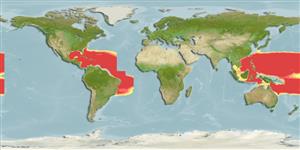>
Trachichthyiformes (Roughies) >
Anoplogastridae (Fangtooths)
Etymology: Anoplogaster: Greek, ana = up + Greek, oplon = shield + Greek, gaster = stomach (Ref. 45335); brachycera: From the main characters of the young specimens which have short temporal and pre-opercular spines.
Environment: milieu / climate zone / depth range / distribution range
Ecologia
marinhas batipelágico; intervalo de profundidade 0 - 1500 m (Ref. 31253). Deep-water
Pacific and Atlantic: tropical waters, from the Sulu Sea in the western Pacific and from the Gulf of Mexico to north of the Bahamas Islands in the western Atlantic (Ref. 50735); off southeastern USA (Moore, pers. comm.).
Tamanho / Peso / Idade
Maturity: Lm ? range ? - ? cm
Max length : 6.0 cm SL macho/indeterminado; (Ref. 31253)
Minimum depth from Ref. 58018.
Ciclo de vida ou comportamento de acasalamento
Maturidade | Reprodução | Desova | Ovos | Fecundidade | Larvas
Paxton, J.R., 1999. Order Beryciformes. Anoplogastridae. Fangtooths. p. 2210. In K.E. Carpenter and V.H. Niem (eds.) FAO species identification guide for fishery purposes. The living marine resources of the WCP. Vol. 4. Bony fishes part 2 (Mugilidae to Carangidae). FAO, Rome. (Ref. 9852)
Status na Lista Vermelha da UICN (Ref. 130435: Version 2024-1)
Ameaça para os humanos
Harmless
Uso pelos humanos
Pescarias: sem interesse
Ferramentas
Relatórios especiais
Baixar XML
Fontes da internet
Estimates based on models
Preferred temperature (Ref.
123201): 7.2 - 18.9, mean 11.1 °C (based on 563 cells).
Índice de diversidade filogenética (Ref.
82804): PD
50 = 1.0000 [Uniqueness, from 0.5 = low to 2.0 = high].
Bayesian length-weight: a=0.01995 (0.00906 - 0.04395), b=3.01 (2.83 - 3.19), in cm total length, based on all LWR estimates for this body shape (Ref.
93245).
Nível Trófico (Ref.
69278): 3.3 ±0.5 se; based on size and trophs of closest relatives
Fishing Vulnerability (Ref.
59153): Low vulnerability (10 of 100).
